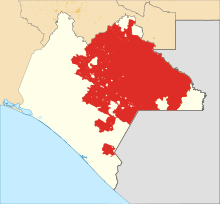
Back Municipios Autónomos Rebeldes Zapatistas AN بلديات زاباتيستا الثورية المستقلة Arabic Municipis Autònoms Rebels Zapatistes Catalan Αυτόνομοι Εξεγερμένοι Δήμοι των Ζαπατίστας Greek Ribelaj Zapatismaj Aŭtonomaj Komunumoj Esperanto Municipios Autónomos Rebeldes Zapatistas Spanish Udalerri Autonomo Matxino Zapatistak Basque Municipalités autonomes rebelles zapatistes French Municípios Autônomos Zapatistas Rebeldes Portuguese Asi Zapatista Özerk Belediyeleri Turkish
| Rebel Zapatista Autonomous Municipalities Municipios Autónomos Rebeldes Zapatistas (Spanish) | |
|---|---|
| Autonomous governmental units of Mexico | |
| 1994–2023 | |
 Territory controlled by the Zapatistas in Chiapas at their peak | |
| Anthem | |
| Himno Zapatista | |
| Capital | None (de jure) Oventik (Tiamnal, Larráinzar) (de facto)[1] |
| Demonym | Zapatista |
| Area | |
| • Coordinates | 16°55′33″N 92°45′37″W / 16.92583°N 92.76028°W |
• 2018 | 24,403 km2 (9,422 sq mi) |
| Population | |
• 2018 | 300,000[2][3] |
| Status | Former de facto autonomous region of Chiapas |
| Government | Councils of Good Government |
| • Type | Municipal council |
| • Motto | Aquí manda el Pueblo y el Gobierno Obedece (Spanish) "Here the people rule and the government obeys" |
| History | |
| 1 January 1994 | |
• Caracoles established[4] | 9 August 2003 |
• Sixth Declaration of the Selva Lacandona[5] | 30 June 2005 |
• Dissolved[6] | 5 November 2023 |
• Reorganised as Local Autonomous Governments[7] | 12 November 2023 |
The Rebel Zapatista Autonomous Municipalities (Spanish: Municipios Autónomos Rebeldes Zapatistas, MAREZ) were the basic governmental units utilized until 2023 within the de facto autonomous territories controlled by neo-Zapatista support bases in the Mexican state of Chiapas. They were founded following the Zapatista uprising which took place in 1994[8] and were part of the wider Chiapas conflict. Despite attempts at negotiation with the Mexican government which resulted in the San Andrés Accords in 1996, the region's autonomy remains unrecognized by that government.[9]
The Zapatista Army of National Liberation (EZLN) does not hold formal political power in Zapatista governance. According to its constitution, no commander or member of the Clandestine Revolutionary Indigenous Committee may take positions of authority or government in these spaces.[10]
The MAREZ were found within the official municipalities, and several were even within the same municipality, as in the case of San Andrés Larráinzar and Ocosingo. The MAREZ were coordinated by autonomous Zapatista Councils of Good Government (Spanish: Juntas de Buen Gobierno) and their main objectives were to promote education and health in their territories. They also fought for land rights, labor and trade, housing, and fuel-supply issues, promoting arts (especially indigenous language and traditions), and administering justice.[11]
On 17 August 2019, the Zapatistas announced a significant increase of autonomous municipalities, and a new term for centers of Zapatista autonomy. In most cases these Centers of Autonomous Resistance and Zapatista Rebellion (Spanish: Centros de Resistencia Autónoma y Rebeldía Zapatista, CRAREZ) include a Caracol (English: "Snail"), a Council of Good Government, and a Rebel Autonomous Zapatista Municipality (MAREZ). The Zapatistas credited this growth primarily to the efforts of "women, men, children, and elders of the Zapatista bases of support" and secondarily to a backfiring counter-insurgency strategy of the Mexican state, which "generate[s] conflict and demoralization" among non-Zapatistas.[12] Eleven new Centers of Autonomous Resistance and Zapatista Rebellion (CRAREZ) were declared; specifically, four new autonomous municipalities and seven new Caracoles (each accompanied by a Council of Good Government). This raised the total number of Caracoles from five to twelve, and brought the total number of autonomous Zapatistas centers to 43, including 27 original autonomous Zapatista municipalities, 5 original Caracoles, and the 11 autonomous Zapatista centers newly declared.[12]
In November 2023, after increased cartel violence, the EZLN announced the reorganization of Zapatista autonomy and dissolution of the MAREZ, with only the Caracoles remaining open to locals. Later that month, they announced the reorganisation of the MAREZ into thousands of "Local Autonomous Governments" (GAL) which form area-wide "Zapatista Autonomous Government Collectives" (CGAZ) and zone-wide "Assemblies of Collectives of Zapatista Autonomous Governments" (ACGAZ).[7]
- ^ "Caracoles y Juntas de Buen Gobierno". Archived from the original on 19 August 2013. Retrieved 21 July 2018.
{{cite web}}: CS1 maint: unfit URL (link) - ^ Vidal, John (17 February 2018). "Mexico's Zapatista rebels, 24 years on and defiant in mountain strongholds". The Guardian. ISSN 1756-3224. Retrieved 8 November 2023.
- ^ Innes, Erin (17 February 2018). ""We don't need permission to be free": Women Zapatistas and the "modernization" of NAFTA". Briarpatch. ISSN 0703-8968. Retrieved 8 November 2023.
- ^ Gonzlez Casanova, Pablo (11 September 2003). "Los caracoles zapatistas: Redes de resistencia y autonoma". La Jornada (in Spanish). Retrieved 8 November 2023.
- ^ "Sixth Declaration of the Selva Lacandona". Enlace Zapatista. 30 June 2005. Retrieved 8 November 2023.
- ^ Cite error: The named reference
APwas invoked but never defined (see the help page). - ^ a b Insurgent Subcommander Moisés (13 November 2023). "Ninth Part: The new structure of Zapastista Autonomy". Enlace Zapatista. Retrieved 13 November 2023.
- ^ Reyes Godelmann, Iker (30 July 2014). "The Zapatista Movement: The Fight for Indigenous Rights in Mexico". Australian Institute of International Affairs. Retrieved 16 June 2020.
- ^ Villegas, Paulina (26 August 2017). "In a Mexico 'Tired of Violence,' Zapatista Rebels Venture Into Politics". The New York Times. ISSN 0362-4331. Retrieved 7 May 2020.
- ^ Gloria Muñóz Ramírez (2003). 20 y 10 el fuego y la palabra. Revista Rebeldía y Demos, Desarrollo de Medios, S.A. de C.V. La Jornada Ediciones.
- ^ Subcomandante Insurgente Marcos (July 2003). "Chiapas: La treceava estela". Cartas y comunicados del EZLN.
- ^ a b Moisés, Subcomandante Insurgente (17 August 2019). "Communique from the EZLN's CCRI-CG And, We Broke the Siege". Enlace Zapatista. Retrieved 8 November 2023.
© MMXXIII Rich X Search. We shall prevail. All rights reserved. Rich X Search

